Mary Anne Yarde's Blog: The Coffee Pot Book Club , page 216
October 26, 2016
Author’s Inspiration ~ Jennifer C. Wilson #HistFic #paranormal @inkjunkie1984
Please give a warm welcome to historical-paranormal author, Jennifer C. Wilson. Jennifer is going to share with us her inspirations behind…
Kindred Spirits Tower of London
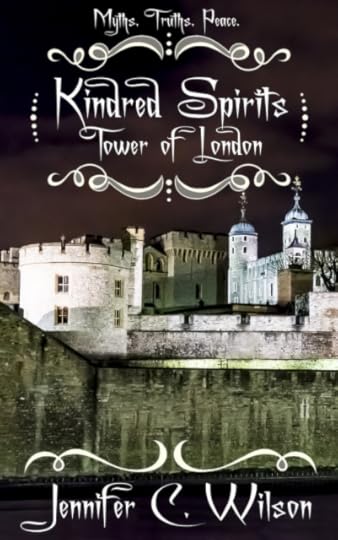
A King, three Queens, a handful of nobles and a host of former courtiers…
In the Tower of London, the dead outnumber the living, with the likes of Tudor Queens Anne Boleyn and Katherine Howard rubbing shoulders with one man who has made his way back from his place of death at Bosworth Field to discover the truth about the disappearance of his famous nephews.
Amidst the chaos of daily life, with political and personal tensions running high, Richard III takes control, as each ghostly resident looks for their own peace in the former palace – where privacy was always a limited luxury.
With so many characters haunting the Tower of London, will they all find the calm they crave?
*** Author’s Inspiration
My inspiration for writing comes from a wide range of sources. Sometimes (rarely, sadly, but lovely when it happens) an idea leaps fully-formed into my head, for example one of the ideas about the life of Richard III I’m currently working on, but most of the time, I’m attracted by a tiny snippet of historical trivia, or even a name. A few years ago, I visited Sweetheart Abbey, and whilst reading about the history of the place, came across Dervorguilla of Galloway, who founded the abbey in memory of her husband. I loved the name, and have subsequently imagined a whole story around a woman of the same name, nothing to do with the real Dervorguilla’s life story at all.
Likewise, the feel of a place can have a significant effect on me. Some places just have a ‘sense’ to them, whether that’s foreboding, romantic, welcoming, or fear. Even without knowing the history of a site (and sometimes it’s better this way), you can get a feel of what characters made their home there, and what life was like. That for me is enough to spark something off. A dark, almost-hidden corridor is obviously the perfect place for secrets, whether conspiratorial or romantic in nature. Likewise, when perched on a rock in the middle of Glencoe, or standing on Culloden battlefield, my mind is filled with conversations that took place (or should have taken place), and the people who lived and died there. I often imagine being a fly-on-the-wall in such places, imagining what happened behind closed doors, or away from prying eyes.
For my debut published novel, Kindred Spirits: Tower of London, the inspiration came very specifically from a competition for poems about ghosts. I had this idea that if the ghosts of Richard III and Anne Boleyn were to meet, they would have plenty to talk about, and a lot in common. The only place I could logically think their ghosts would both be was the Tower of London, so I worked and worked at the poem.
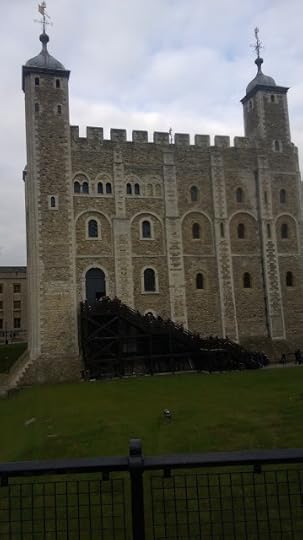
It was dreadful. I didn’t even enter it.
But the idea seemed half-decent, and worth sticking with. I kept reading and researching, finding out who else might be about, and was lucky enough to visit the Tower twice during 2013, in the run-up to NaNoWriMo. By the time November came around, I had my cast, or the central group at least. Anne Boleyn was still my heroine, but I added Katherine Howard, Jane Grey, Jane Boleyn, Georges Boleyn and Plantagenet and William Hastings. Most were from a fairly narrow historical range, but I thought trying to incorporate everyone who had a reason to haunt the Tower would rapidly get out of hand! Looking over peoples’ life stories, relationships and opinions gave me plenty of scope as to who would have some interesting conversations with who, and whether friendships would form or fail as history progressed.
For those who have never taken part in National Novel Writing Month (NaNoWriMo), I cannot recommend it highly enough. True, you can say goodbye to a decent night’s sleep for a month, and being able to live by ‘heating up’ rather than ‘cooking’ is a benefit, but if you ‘win’, then your prize is glorious – 50,000 words (or more, if you’re a real glutton for punishment!). Thanks to long evenings, a few days of annual leave, and the television’s off-switch, I made it. And then stopped. I glanced at it once or twice in the following year, always thinking I should do something with it, but never quite getting around to it.
Then they found Richard.
There’s a limited band of writers who can say that their hero made national (and international) news by being found in a carpark! Finding Richard III’s body in Leicester helped boost my motivation, especially once I’d been to the new Visitor Centre and seen the grave-site. It’s been beautifully presented, in almost a chapel-like setting. It still wasn’t quite enough though.
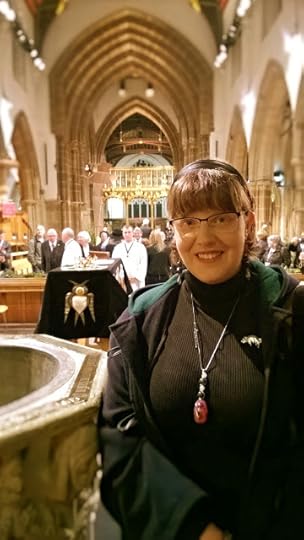
It was the funeral that did it. I’d entered the ballot for a place just to be a part of the whole experience – he was my favourite monarch, my leading man: how could I not go for a place at the re-burial? The envelope arrived, crisp white and gold-trimmed, in early 2015. My first thought was how nice it was, that the organisers had written to everyone to let them know they were unsuccessful; nope, I had a place at Compline. In truth, I didn’t even know what Compline was, but really, did it matter to me? I was going to part of Richard III’s funeral!
This, then, was the final push that I needed. One month after the service in Leicester, my manuscript was edited, polished and submitted. From there, things just went from good to better, with the novel being published as an e-book by Crooked Cat Publishing in October 2015, and in paperback in April 2016.
As for my latest inspiration, holding a copy of my own novel in my hands will take a lot to beat!
Links to Purchase
Only 0.99
(27th ~ 31st October) Amazon
About the author

Jennifer is a marine biologist by training, who developed an equal passion for history whilst stalking Mary, Queen of Scots of childhood holidays (she has since moved on to Richard III). She completed her BSc and MSc at the University of Hull, and has worked as a marine environmental consultant since graduating.
Enrolling on an adult education workshop on her return to the north-east reignited Jennifer’s pastime of creative writing, and she has been filling notebooks ever since. In 2014, she won the Story Tyne short story competition, and also continues to work on developing her poetic voice, reading at a number of events, and with several pieces available online. Her debut novel Kindred Spirits: Tower of London was published by Crooked Cat Publishing as an e-book in October 2015, and paperback in May 2016.
Useful Links Twitter Facebook Blog
Published on October 26, 2016 00:00
October 21, 2016
Pre-Order Blitz ~ Marmalade’s First Christmas @pmillhouse @SecretRealmBook

Marmalade’s First Christmas
A NovellaBy Paula MillhousePre-Order Blitz


When billionaire Jake Simons rescues a kitten the week before Christmas, the orange tabby cat leads Jake to the greatest gift of the season - Veterinarian Marley West.The last thing Marley needs is a client meddling in her personal business, but Old Man Winter, Mother Nature, and Jake’s pregnant mares have other plans for her holiday. When she gets snowed in with Jake during the worst blizzard in racehorse country, sparks fly.But will Jake be strong enough to let go of ghosts from his past? And, in this friends-to-lovers story, will Marley learn to trust that Jake just might be her very own Christmas miracle?

Jake woke to an empty bed, and he startled up. Where was she? He tugged on a pair of sweats and a shirt, and left the bedroom searching for her.What he found both surprised and pleased him.
“You’re up early,” she said, grinning at him with that breathtaking smile. She was sitting on the cushions in front of the fire, sipping a mug of something warm, reading one of his mother’s old romance novels. Marmalade was purring on her lap, and the Christmas Tree, the only other light besides the crackling fire lit up the room. “I found hot chocolate in the kitchen,” Marley said.Jake took the mug and sniffed it. “Oh, this won’t do. Give me a sec and I’ll make you something amazing.”He got up to go make the drinks, and Marley followed him. She watched him like a hawk as he simmered heavy cream, cinnamon sticks, and carved a big block of dark chocolate. “The secret is in not letting the cream reach a full boil.” He turned to the pantry and pulled out a bottle of Baileys Irish Cream. “And Baileys, of course.”He poured the steaming elixir into big cheerful Snowman Mugs, added a shot of the liqueur, and then stirred a striped red and white candy cane in each mug. “Merry Christmas.”She took one sip, and her eyes rolled back in her head. “Oh, Holy Night, this is incredible.”He laughed, and sipped his cup too. “Pretty tasty.”“I love this time of year, you know. It’s as if this one week, everything is perfect. Unblemished. Full of possibilities.”She had a chocolate mustache from the drink, and he reached in and touched her upper lip. “You got a little something right there…”She giggled. He swiped his tongue across the chocolate on her lips. He groaned. Her soft full lips tasted even better with chocolate on them. “This is turning out to be my favorite week this year too.”She blushed, and her whole face turned holly berry red. Her delicately curved neck too. He took the mug from her hands, set it down, and backed her up to the granite counter. He kissed her properly, thoroughly, deeply. She sighed, so he knew he’d gotten it right. The tingly taste of peppermint and chocolate on her tongue instantly became his favorite new treat. “Mmm…”The kitchen heated up with their kisses, but a few moments later she pulled away and said, “We should go check on the mares, and their babies.”

Amazon Pre-Order Link Barnes & Noble All Romance eBooks Goodreads Website

 I write books.Books where romance, fantasy, and suspense collide.Born and raised in Savannah, Georgia, where Spanish moss whispers tales in breezes from the Atlantic Ocean, as a child I soaked in the sunshine and heritage of cobblestones, pirate lore, and stories steeped in savory mysteries of the South. I graduated with honors from both Armstrong Atlantic State University, and Georgia Southern University.I live in the mountains now with my husband, but honor my southern heritage as a storyteller by sharing high heat adventures in romance fiction with readers.What’s in it for you?A reward. Treat yourself to an entertaining diversion from your daily routine by reading my stories. You’ll find themes like, justice does exist, love is worth fighting for, and happily ever afters are expected.
I write books.Books where romance, fantasy, and suspense collide.Born and raised in Savannah, Georgia, where Spanish moss whispers tales in breezes from the Atlantic Ocean, as a child I soaked in the sunshine and heritage of cobblestones, pirate lore, and stories steeped in savory mysteries of the South. I graduated with honors from both Armstrong Atlantic State University, and Georgia Southern University.I live in the mountains now with my husband, but honor my southern heritage as a storyteller by sharing high heat adventures in romance fiction with readers.What’s in it for you?A reward. Treat yourself to an entertaining diversion from your daily routine by reading my stories. You’ll find themes like, justice does exist, love is worth fighting for, and happily ever afters are expected.

Amazon Author Page https://www.amazon.com/-/e/B006991RF8My Newsletter: https://paulamillhouse.com/paula-millhouse-books-newsletter/Website https://www.paulamillhouse.comBlog https://www.paulamillhouse.comTwitter https://twitter.com/pmillhouseFacebook Page https://www.facebook.com/paulamillhousefansFacebook https://www.facebook.com/PaulaMillhouse.AuthorGoodreads https://www.goodreads.com/author/show/5398221.Paula_MillhouseGooglePlus https://plus.google.com/+PaulaMillhouse/postsPinterest http://www.pinterest.com/pmillhouse/boards/You Tube https://youtu.be/q2FCU-gJPog
Hosted By:Secret Realm Book Reviews & Services
Published on October 21, 2016 00:00
October 19, 2016
Author’s Inspiration ~ Dean Hamilton #HistFic @Tyburn__Tree
It is my very great pleasure to welcome Historical Fiction author, Dean Hamilton onto the blog. Dean is going to tell us about the inspirations behind his latest book.The Jesuit Letter
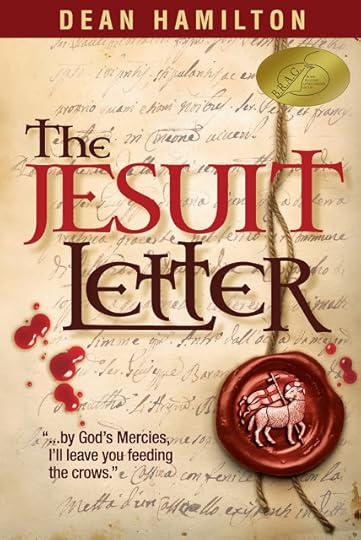
England 1575.Ex-soldier turned play-actor Christopher Tyburn thought he had left bloodshed and violence behind him when he abandoned the war against the Spanish in Flanders, but fate has different and far bloodier plans waiting.The innyards of London are closed due to plague and the playing troupe The Earl of Worcester’s Men are on the road, touring the market-towns of the Midlands.When Tyburn accidentally intercepts a coded letter from a hidden Jesuit priest in Warwickshire, he is entangled in a murderous and deadly conspiracy. Stalked by unknown enemies, he must race to uncover the conspiracy and hunt down the Jesuit to clear his name. . . or die a traitor’s death. His only hope – an eleven-year old glover’s son named William Shakespeare.This novel has been selected by the Historical Novel Society as an Editors’ Choice and Short-listed for the 2016 HNS Indie Award. It has also been selected as a Semi-Finalist for the 2016 M.M. Bennetts Award for Historical Fiction. It was recently awarded an Indie B.R.A.G Medallion.***Author’s Inspiration
 You might think, given the subject matter, that the primary inspiration for THE JESUIT LETTER was William Shakespeare, however, in actuality it was his father.I knew relatively little about Shakespeare’s family and upbringing until I happened to read Stephen Greenblatt’s Will in the World: How Shakespeare Became Shakespeare. Greenblatt, like many biographers before (and after) him, pulls together threads, ideas and commonalities from Shakespeare’s many works, drawing parallels between the limited evidentiary knowledge we have about Shakespeare’s life and upbringing, and tying in supposition, guesswork and context to try and draw a picture of the life of the famous Bard of Stratford-Upon-Avon.What surprised me, was that John Shakespeare – Will’s father – actually had rather more documentation accessible about him than his much more famous son. John Shakespeare was a glover by trade, but also held a number of properties and agricultural interests including an active role as a brogger, illegally trading in wool. He served as a municipal ale taster, a constable, an alderman, and eventually mayor (High Bailiff) of Stratford-Upon-Avon. By all accounts, he was one of Stratford’s leading citizens but in 1575, it all started to apparently go downhill. Records indicate a series of property sales and ownership transfers, the loss of his position as an alderman due to non-attendance, and usury charges over the next decade. The question that has intrigued scholars is why? What caused John Shakespeare’s reversal of fortune, which saw him slide from aspiring gentleman (he applied for a coat-of-arms in 1569, an application that was allowed to lay fallow until revived by Will in 1596) to a man withdrawn from public life. Research led to a number of different cited possibilities including alcoholism (for which there is zero evidence, only speculation assumptions and guesses based on a handful of lines cited from Will Shakespeare’s plays), issues with the Courts due to his usury and brogging charges, commercial speculation, depression (8 children, of whom only 5 survived to adulthood) or illness, and Catholicism.Of the many cited possibilities, the question of Shakepeare’s Catholicism is probably the most telling. His withdrawal from public position coincided both with fines paid for his wife’s continued absences from Protestant church services, and the arrival of the new Bishop of Worcester, an ardent anti-Catholic, in Stratford on a visitation. Mary Shakespeare’s maiden name was Mary Arden, one of Warwickshire’s leading families and one vehemently identified with the Catholic faith. The titular head of the Arden family, Edward Arden (who also makes an appearance in The Jesuit Letter) was openly Catholic and at terrible odds with Robert Dudley, the Earl of Leicester, the Queen’s favorite councilor. In addition a Catholic testament supposedly with John Shakespeare’s name upon it was uncovered in the rafters of the Shakespeare family home on Henley Street in the 18thc, though some scholars doubt its veracity. Some have speculated that Shakespeare deliberately divested himself of his properties only on paper – transferring ownership and “conveying land and goods” to his friends to avoid possible recusancy fines, bitter taxation and potential property confiscation due to his Catholic faith.The other piece of (entirely speculative) commentary that Greenblatt noted that caught my eye was whether young Will could have attended any of the performances of the travelling theatre troupes that his father is documented as paying for as mayor in 1569, and, more tellingly, whether Will attended the famous celebrations held at Kenilworth Castle, when Queen Elizabeth’s Summer Progress rolled through in the summer of 1575. Many scholars have seen significant parallels between Shakespeare’s A Midsummer Night’s Dream, and the staged performances, fireworks shows and events held at Kenilworth by the Earl of Leicester to honour (and woo) the Queen. There is a superb record of the Kenilworth events documented in the Langham Letter from 1575.This tiny, dangling bit of supposition about what actually happened to alter John Shakespeare’s fortunes made me wonder – about playing troupes, the hidden life of Catholic recusants, the corrosive political and religious strife that had torn England apart over the preceding thirty years, the knife-edge that Elizabeth’s reign balanced on between hard-line Protestantism and a dangerous fanatical Catholicism, and the every-day, ordinary lives that had to determine their own fates, in a time when landing on the wrong side of the fence at the wrong time could result in torture and death.Most fiction embedded in the Elizabethan era tends to be tales of Court intrigue, set amidst the silken splendor of palaces. Mine tends to hang about in ale-soaked taverns, muddy streets and fetid back-alleys where cold-steel by lantern light offers redemption or grim death by turns…So just what would happen if a battered ex-soldier turned play-actor, venturing about on a summer playing tour in the Midlands, stumbled into vicious conspiracy and murder in the quiet town of Stratford-Upon-Avon?Well, you will have to read the book to find out.
You might think, given the subject matter, that the primary inspiration for THE JESUIT LETTER was William Shakespeare, however, in actuality it was his father.I knew relatively little about Shakespeare’s family and upbringing until I happened to read Stephen Greenblatt’s Will in the World: How Shakespeare Became Shakespeare. Greenblatt, like many biographers before (and after) him, pulls together threads, ideas and commonalities from Shakespeare’s many works, drawing parallels between the limited evidentiary knowledge we have about Shakespeare’s life and upbringing, and tying in supposition, guesswork and context to try and draw a picture of the life of the famous Bard of Stratford-Upon-Avon.What surprised me, was that John Shakespeare – Will’s father – actually had rather more documentation accessible about him than his much more famous son. John Shakespeare was a glover by trade, but also held a number of properties and agricultural interests including an active role as a brogger, illegally trading in wool. He served as a municipal ale taster, a constable, an alderman, and eventually mayor (High Bailiff) of Stratford-Upon-Avon. By all accounts, he was one of Stratford’s leading citizens but in 1575, it all started to apparently go downhill. Records indicate a series of property sales and ownership transfers, the loss of his position as an alderman due to non-attendance, and usury charges over the next decade. The question that has intrigued scholars is why? What caused John Shakespeare’s reversal of fortune, which saw him slide from aspiring gentleman (he applied for a coat-of-arms in 1569, an application that was allowed to lay fallow until revived by Will in 1596) to a man withdrawn from public life. Research led to a number of different cited possibilities including alcoholism (for which there is zero evidence, only speculation assumptions and guesses based on a handful of lines cited from Will Shakespeare’s plays), issues with the Courts due to his usury and brogging charges, commercial speculation, depression (8 children, of whom only 5 survived to adulthood) or illness, and Catholicism.Of the many cited possibilities, the question of Shakepeare’s Catholicism is probably the most telling. His withdrawal from public position coincided both with fines paid for his wife’s continued absences from Protestant church services, and the arrival of the new Bishop of Worcester, an ardent anti-Catholic, in Stratford on a visitation. Mary Shakespeare’s maiden name was Mary Arden, one of Warwickshire’s leading families and one vehemently identified with the Catholic faith. The titular head of the Arden family, Edward Arden (who also makes an appearance in The Jesuit Letter) was openly Catholic and at terrible odds with Robert Dudley, the Earl of Leicester, the Queen’s favorite councilor. In addition a Catholic testament supposedly with John Shakespeare’s name upon it was uncovered in the rafters of the Shakespeare family home on Henley Street in the 18thc, though some scholars doubt its veracity. Some have speculated that Shakespeare deliberately divested himself of his properties only on paper – transferring ownership and “conveying land and goods” to his friends to avoid possible recusancy fines, bitter taxation and potential property confiscation due to his Catholic faith.The other piece of (entirely speculative) commentary that Greenblatt noted that caught my eye was whether young Will could have attended any of the performances of the travelling theatre troupes that his father is documented as paying for as mayor in 1569, and, more tellingly, whether Will attended the famous celebrations held at Kenilworth Castle, when Queen Elizabeth’s Summer Progress rolled through in the summer of 1575. Many scholars have seen significant parallels between Shakespeare’s A Midsummer Night’s Dream, and the staged performances, fireworks shows and events held at Kenilworth by the Earl of Leicester to honour (and woo) the Queen. There is a superb record of the Kenilworth events documented in the Langham Letter from 1575.This tiny, dangling bit of supposition about what actually happened to alter John Shakespeare’s fortunes made me wonder – about playing troupes, the hidden life of Catholic recusants, the corrosive political and religious strife that had torn England apart over the preceding thirty years, the knife-edge that Elizabeth’s reign balanced on between hard-line Protestantism and a dangerous fanatical Catholicism, and the every-day, ordinary lives that had to determine their own fates, in a time when landing on the wrong side of the fence at the wrong time could result in torture and death.Most fiction embedded in the Elizabethan era tends to be tales of Court intrigue, set amidst the silken splendor of palaces. Mine tends to hang about in ale-soaked taverns, muddy streets and fetid back-alleys where cold-steel by lantern light offers redemption or grim death by turns…So just what would happen if a battered ex-soldier turned play-actor, venturing about on a summer playing tour in the Midlands, stumbled into vicious conspiracy and murder in the quiet town of Stratford-Upon-Avon?Well, you will have to read the book to find out.Purchase LinksAmazon KindleAmazon SoftcoverB&N Softcover
About the author Dean Hamilton works as a marketing professional by day and prowls the imaginary alleyways of the Elizabethan era in his off-hours. He is married, with a son, a dog, four cats and a turtle. The Jesuit Letter is his first novel.Useful Links WebsiteFacebook
(A note from Mary - I reviewed The Jesuit Letter, back in January of this year. You can find out what I thought of the book…here!!)
Published on October 19, 2016 00:00
October 18, 2016
The National Wallace Monument ~ #MustSee #Scotland
You cannot go to Scotland and not climb The National Wallace Monument ~ she says!
I have a little issue when it comes to heights, which for someone who spends an awful lot of time, climbing old crumbling spiral staircases in ruined castles, may come as a bit of a surprise ~ you have no idea!

This isn't the first time I have attempted to climb the Monument. The first time was about 16 years ago, and I made it to the room where William Wallace's sword was, by which time I was feeling sick, dizzy and had an irrational fear that I was never going to leave this chamber again.
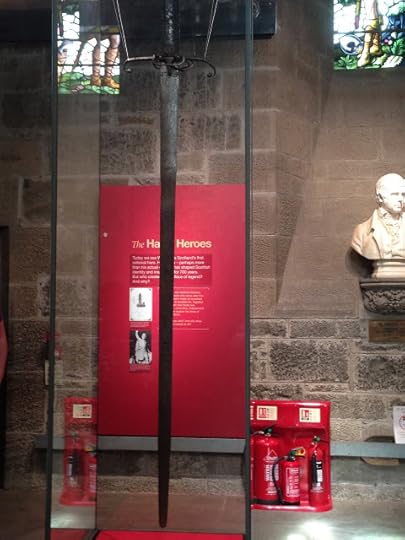 William Wallace's actual sword!
William Wallace's actual sword!
Fast-forward to present day, and I found myself once again looking at that never ending spiral staircase. This time, I had a determined teenager with me who was going to reach the top, and she would do so, even if it meant dragging me up those steps.
Needless to say, it took a little bit of encouragement and a big dollop of patience ~ but hey, we weren't in a rush, well I wasn't anyway!

I think we all know who William Wallace is ~ if not, where were you in 1995 when Braveheart hit the big screens?
Now the locals call Braveheart "that comedy" as there isn't much factually correct with it. But, there was a battle between Wallace and his army of loyal followers, and the English.

Let's give the battle it's real name, which is The Battle of Stirling Bridge. Now, Wallace wasn't the only one who had been, shall we say resisting, English rule. There was a Scottish nobleman called Andrew Moray who had been doing his fair share of harassing the English army. Wallace and Moray finally joined forces, and they gathered their troops on the slope of rock, known locally as Abbey Craig and from their position they watched the formidable forces of the English army gather under the leadership of John du Warenne and Hugh de Cressingham.

The Scots were outnumbered. The English had somewhere in the region of 200-300 knights on horseback and 10,000-foot soldiers. The Scots had 8,000-foot soldiers and only 36 horsemen. The English were confident in their numbers. There was no way they were going to lose to this rabble.
Two Dominican friars were sent as envoys to negotiate the Scottish surrender. Wallace replied...
"Tell your commander that we are not here to make peace but to do battle, defend ourselves and liberate out kingsmen. Let them come on, and we shall prove this in their very beards."

The English realised that the Scots were not going to come to them. They were going to have to cross the River Forth and teach these traitors a lesson.
Richard Lundie, a Scottish knight, fighting for the English, said to his commanding officers...
"My Lords, if we go across the bridge we are dead men."
 Old Stirling Bridge ~ photo from Wikipedia
Old Stirling Bridge ~ photo from Wikipedia
Warrene should have listened to him, but he was so arrogantly confident that this battle would be a mere sword exercise for the men, that he did not heed the warning. The might of the English cavalry crossed the bridge and waited in the loop of the River Forth, while Wallace and Moray watched and prepared the men and when the time was right, they seized the moment. The Scottish spearmen cut off the escape back across the bridge and the English army, floundering in the marshy ground, were slaughtered.
Warrene must have watched with disbelieving eyes as these rebels massacred his men. He ordered for the bridge to be burnt and he retreated to Berwick. It was a decisive Scottish victory, and it wouldn't be the last.

The National Wallace Monument was designed by the Edinburgh-born Glasgow architect J. T. Rochead, and it was built between 1861 and 1869. It is 67 meters high and has 246 steps. I feel sick just thinking about it.
But it is so worth the climb. Not only do you get to see Wallace's actual sword but the views across Stirling are breathtaking ~ but, I have to be honest, I was really glad to get back down again!

You cannot go to Scotland and not climb the Wallace Monument ~ and despite my fear of heights, I am glad that this time, I made it to the top!
I have a little issue when it comes to heights, which for someone who spends an awful lot of time, climbing old crumbling spiral staircases in ruined castles, may come as a bit of a surprise ~ you have no idea!

This isn't the first time I have attempted to climb the Monument. The first time was about 16 years ago, and I made it to the room where William Wallace's sword was, by which time I was feeling sick, dizzy and had an irrational fear that I was never going to leave this chamber again.
 William Wallace's actual sword!
William Wallace's actual sword!Fast-forward to present day, and I found myself once again looking at that never ending spiral staircase. This time, I had a determined teenager with me who was going to reach the top, and she would do so, even if it meant dragging me up those steps.
Needless to say, it took a little bit of encouragement and a big dollop of patience ~ but hey, we weren't in a rush, well I wasn't anyway!

I think we all know who William Wallace is ~ if not, where were you in 1995 when Braveheart hit the big screens?
Now the locals call Braveheart "that comedy" as there isn't much factually correct with it. But, there was a battle between Wallace and his army of loyal followers, and the English.

Let's give the battle it's real name, which is The Battle of Stirling Bridge. Now, Wallace wasn't the only one who had been, shall we say resisting, English rule. There was a Scottish nobleman called Andrew Moray who had been doing his fair share of harassing the English army. Wallace and Moray finally joined forces, and they gathered their troops on the slope of rock, known locally as Abbey Craig and from their position they watched the formidable forces of the English army gather under the leadership of John du Warenne and Hugh de Cressingham.

The Scots were outnumbered. The English had somewhere in the region of 200-300 knights on horseback and 10,000-foot soldiers. The Scots had 8,000-foot soldiers and only 36 horsemen. The English were confident in their numbers. There was no way they were going to lose to this rabble.
Two Dominican friars were sent as envoys to negotiate the Scottish surrender. Wallace replied...
"Tell your commander that we are not here to make peace but to do battle, defend ourselves and liberate out kingsmen. Let them come on, and we shall prove this in their very beards."

The English realised that the Scots were not going to come to them. They were going to have to cross the River Forth and teach these traitors a lesson.
Richard Lundie, a Scottish knight, fighting for the English, said to his commanding officers...
"My Lords, if we go across the bridge we are dead men."
 Old Stirling Bridge ~ photo from Wikipedia
Old Stirling Bridge ~ photo from WikipediaWarrene should have listened to him, but he was so arrogantly confident that this battle would be a mere sword exercise for the men, that he did not heed the warning. The might of the English cavalry crossed the bridge and waited in the loop of the River Forth, while Wallace and Moray watched and prepared the men and when the time was right, they seized the moment. The Scottish spearmen cut off the escape back across the bridge and the English army, floundering in the marshy ground, were slaughtered.
Warrene must have watched with disbelieving eyes as these rebels massacred his men. He ordered for the bridge to be burnt and he retreated to Berwick. It was a decisive Scottish victory, and it wouldn't be the last.

The National Wallace Monument was designed by the Edinburgh-born Glasgow architect J. T. Rochead, and it was built between 1861 and 1869. It is 67 meters high and has 246 steps. I feel sick just thinking about it.
But it is so worth the climb. Not only do you get to see Wallace's actual sword but the views across Stirling are breathtaking ~ but, I have to be honest, I was really glad to get back down again!

You cannot go to Scotland and not climb the Wallace Monument ~ and despite my fear of heights, I am glad that this time, I made it to the top!
Published on October 18, 2016 00:00
October 17, 2016
#bookreview ~ The Errant Flock #histfict @AuthoJana
The Errant Flock(The Flock Trilogy Book 1)ByJana Petken
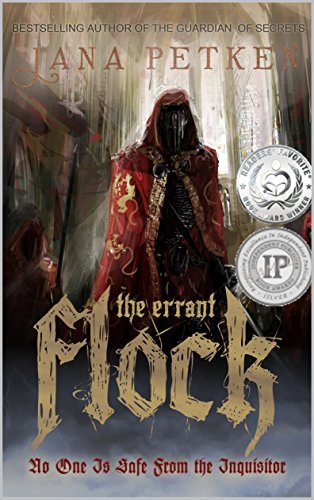 The Multi Award Winning, The Errant Flock, a historical epic of greed, betrayal, and murder, set during the Spanish Inquisition.
The Multi Award Winning, The Errant Flock, a historical epic of greed, betrayal, and murder, set during the Spanish Inquisition.
Valencia, Spain, 1491
The ambitions of four men merge and collide in a deadly game of intrigue.
David Sanz, a young militiaman, is forced to carry out a heinous crime, and he becomes an unwitting pawn in a tense battle for power.
Luis Peráto, the duke of Sagrat, sacrifices his own people to cover up dark secrets that could see him burnt at the stake for treason.
Sergio Garcia, Sagrat’s lord treasurer, is a cruel and unscrupulous man, willing to eliminate anyone who opposes his rise to power.
The inquisitor, Gaspar de Amo, zealously punishes heretics for their sins against Rome and her Holy Office. But bringing the Inquisition to the town of Sagrat proves more challenging than he or the church could ever have envisaged.
In the midst of chaos, the people of Sagrat, terrorized by a series of murders, face an even greater danger with the arrival of the Inquisition and the unimaginable horrors it brings.
*** What did I think of the book?
To be saved from Hell, one must first be purged of the Devil. The inquisitor, Gaspar de Amo, knows all about heretics and their evil hearts. It is his sacred duty to bring the flock back to Christ. But by trying to save the immortal souls of the citizens of Spain, he risks losing his mortal life. But it is a risk he is willing to take, in the name of God and the King.But when he brings his Inquisition to Sagrat, the home of his daughter and her husband Luis Peráto, the Duke of this province, he discovers more than a town full of heretics.
The brutal times of The Spanish Inquisition are brought back to life, in this compelling, page-turner of a read. Full of intrigue, murder and lies, The Errant Flock is a masterpiece of historical fiction. Petkin holds nothing back, with many scenes of torture and death, which makes this a vivid account of what it was like to live under the yolk of the Inquisition. There are many scenes that readers may find upsetting, as neighbour turn on neighbour, in a bid to save their own skins from the evil that the Inquisition was. This is a harrowing account of what it takes to stay alive.
The main protagonist, David Sanz is a well-coloured character, who finds himself embroiled in a web of lies. He commits the most atrocious crime in the services of the Duke. But David soon realises that it isn't just his own guilt that he has to learn to live with. The Duke, now he has used him for his own gains, wants David and everyone he loves to disappear. David has to keep his wits about him and somehow, amid the terror, save the people he loves from not only death but, also a fate worse than it.
This is one of those books that you simply cannot put down. I was desperate to find out what was going to happen next. Full of twists and surprises, this book, kept me guessing. Petkin has brought 15th Century Spain back to life and in particular those early days of The Spanish Inquisition. This book will stay with me for a long time.
I Highly Recommend.
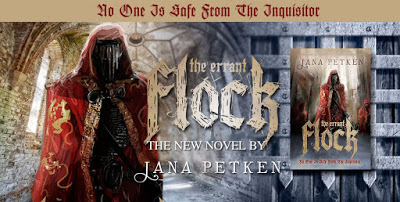
Links for PurchaseAmazon USAmazon UK
About the author

Jana Petken served in the (British) Royal Navy as a leading Wren Regulator, equivalent to a sergeant in the military police.
After the Navy she worked for a travel company as an overseas representative.
She was a security guard at the BBC World Service radio station. Afterwards she spent twelve years as a bodyguard for a Saudi Arabian Princess.
Her final career was as a cabin-crew member for British Airways. Unfortunately, she suffered serious injuries on board a flight. The aircraft, a Boeing 747, was flying at 39,000 feet above Africa when it was caught in clear-air turbulence. As a result of that accident, she endured three major operations on her spinal cord, and was forced into retirement.
Jana Petken is a multi award winning and best selling historical fiction author. Her books include:
The Guardian of Secrets. (2013)
The Mercy Carver Series: Dark Shadows, book 1, and Blood Moon, book 2. (2014)
The Errant Flock: The Flock Trilogy Book 1. (2015)
Swearing Allegiance. (2016)
Coming in October, 2016, The Scattered Flock (The Flock Trilogy book 2)
 The Multi Award Winning, The Errant Flock, a historical epic of greed, betrayal, and murder, set during the Spanish Inquisition.
The Multi Award Winning, The Errant Flock, a historical epic of greed, betrayal, and murder, set during the Spanish Inquisition. Valencia, Spain, 1491
The ambitions of four men merge and collide in a deadly game of intrigue.
David Sanz, a young militiaman, is forced to carry out a heinous crime, and he becomes an unwitting pawn in a tense battle for power.
Luis Peráto, the duke of Sagrat, sacrifices his own people to cover up dark secrets that could see him burnt at the stake for treason.
Sergio Garcia, Sagrat’s lord treasurer, is a cruel and unscrupulous man, willing to eliminate anyone who opposes his rise to power.
The inquisitor, Gaspar de Amo, zealously punishes heretics for their sins against Rome and her Holy Office. But bringing the Inquisition to the town of Sagrat proves more challenging than he or the church could ever have envisaged.
In the midst of chaos, the people of Sagrat, terrorized by a series of murders, face an even greater danger with the arrival of the Inquisition and the unimaginable horrors it brings.
*** What did I think of the book?
To be saved from Hell, one must first be purged of the Devil. The inquisitor, Gaspar de Amo, knows all about heretics and their evil hearts. It is his sacred duty to bring the flock back to Christ. But by trying to save the immortal souls of the citizens of Spain, he risks losing his mortal life. But it is a risk he is willing to take, in the name of God and the King.But when he brings his Inquisition to Sagrat, the home of his daughter and her husband Luis Peráto, the Duke of this province, he discovers more than a town full of heretics.
The brutal times of The Spanish Inquisition are brought back to life, in this compelling, page-turner of a read. Full of intrigue, murder and lies, The Errant Flock is a masterpiece of historical fiction. Petkin holds nothing back, with many scenes of torture and death, which makes this a vivid account of what it was like to live under the yolk of the Inquisition. There are many scenes that readers may find upsetting, as neighbour turn on neighbour, in a bid to save their own skins from the evil that the Inquisition was. This is a harrowing account of what it takes to stay alive.
The main protagonist, David Sanz is a well-coloured character, who finds himself embroiled in a web of lies. He commits the most atrocious crime in the services of the Duke. But David soon realises that it isn't just his own guilt that he has to learn to live with. The Duke, now he has used him for his own gains, wants David and everyone he loves to disappear. David has to keep his wits about him and somehow, amid the terror, save the people he loves from not only death but, also a fate worse than it.
This is one of those books that you simply cannot put down. I was desperate to find out what was going to happen next. Full of twists and surprises, this book, kept me guessing. Petkin has brought 15th Century Spain back to life and in particular those early days of The Spanish Inquisition. This book will stay with me for a long time.
I Highly Recommend.

Links for PurchaseAmazon USAmazon UK
About the author

Jana Petken served in the (British) Royal Navy as a leading Wren Regulator, equivalent to a sergeant in the military police.
After the Navy she worked for a travel company as an overseas representative.
She was a security guard at the BBC World Service radio station. Afterwards she spent twelve years as a bodyguard for a Saudi Arabian Princess.
Her final career was as a cabin-crew member for British Airways. Unfortunately, she suffered serious injuries on board a flight. The aircraft, a Boeing 747, was flying at 39,000 feet above Africa when it was caught in clear-air turbulence. As a result of that accident, she endured three major operations on her spinal cord, and was forced into retirement.
Jana Petken is a multi award winning and best selling historical fiction author. Her books include:
The Guardian of Secrets. (2013)
The Mercy Carver Series: Dark Shadows, book 1, and Blood Moon, book 2. (2014)
The Errant Flock: The Flock Trilogy Book 1. (2015)
Swearing Allegiance. (2016)
Coming in October, 2016, The Scattered Flock (The Flock Trilogy book 2)
Published on October 17, 2016 00:00
October 13, 2016
Culzean Castle and Country Park #MustVisit #Scotland @Culzeancastle
What comes to mind when you think of places to visit in Scotland?Edinburgh Castle,The Wallace Monument,Culloden Battlefield ? … to name but a few.
But here is a piece of advice ~ if you are planning to visit Scotland, why not ask the locals what they think is worth checking out.
If we had not have asked, then we would have missed the little gem that is
Culzean Castle and Country Park.

This is a must-see attraction, especially if you have children. It is managed by the Scottish National Trust, which meant we got in Free. When Exploring Scotland, I really do advise you purchase a membership to The Scottish National Trust and buy an Explorer Pass as well ~ not only will this save you a heap of money, but it will also give you ideas of places to visit.
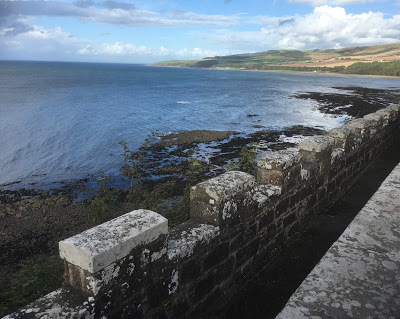
Now a brief history of Culzean. The powerful Kennedy family owned the Culzean estate, and for those who like their architecture, the castle was designed by Robert Adams.
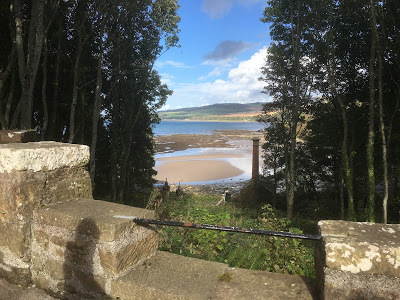
Quick tip ~ give yourself a day. You are so going to need it, especially if you have children because they are not going to want to leave the adventure playground. I have four children, I have been to a lot of playgrounds in my time but the one at Culzean was fantastic. It is a castle playground and there is so much for them to do. My children had a wonderful time ~ so wonderful that they were very reluctant to leave!

The grounds are extensive, with lots of nature walks, a 13-acre lake, a shingle beach, a walled kitchen garden (I always wanted one of those) and a beautiful Pleasure Garden made for Lady Ailsa.

When in Scotland you expect to see deer ~ you can see them at Culzean ~ in fact you can get pretty close to them.

The castle itself was beautiful, and the children enjoyed the children's quiz ~ this one involved looking for Lego men (what a stroke of genius on the NTS part), this kept my youngest engaged throughout the tour! The staff were super friendly and were more than willing to tell you about the history of the castle and the family who once lived there. We had a fantastic time
This is a great day out. If you find yourself in Ayrshire, I Highly Recommend you check out Culzean Castle and Country Park.
But here is a piece of advice ~ if you are planning to visit Scotland, why not ask the locals what they think is worth checking out.
If we had not have asked, then we would have missed the little gem that is
Culzean Castle and Country Park.

This is a must-see attraction, especially if you have children. It is managed by the Scottish National Trust, which meant we got in Free. When Exploring Scotland, I really do advise you purchase a membership to The Scottish National Trust and buy an Explorer Pass as well ~ not only will this save you a heap of money, but it will also give you ideas of places to visit.

Now a brief history of Culzean. The powerful Kennedy family owned the Culzean estate, and for those who like their architecture, the castle was designed by Robert Adams.

Quick tip ~ give yourself a day. You are so going to need it, especially if you have children because they are not going to want to leave the adventure playground. I have four children, I have been to a lot of playgrounds in my time but the one at Culzean was fantastic. It is a castle playground and there is so much for them to do. My children had a wonderful time ~ so wonderful that they were very reluctant to leave!

The grounds are extensive, with lots of nature walks, a 13-acre lake, a shingle beach, a walled kitchen garden (I always wanted one of those) and a beautiful Pleasure Garden made for Lady Ailsa.

When in Scotland you expect to see deer ~ you can see them at Culzean ~ in fact you can get pretty close to them.

The castle itself was beautiful, and the children enjoyed the children's quiz ~ this one involved looking for Lego men (what a stroke of genius on the NTS part), this kept my youngest engaged throughout the tour! The staff were super friendly and were more than willing to tell you about the history of the castle and the family who once lived there. We had a fantastic time
This is a great day out. If you find yourself in Ayrshire, I Highly Recommend you check out Culzean Castle and Country Park.
Published on October 13, 2016 00:00
October 12, 2016
Author's Inspiration – Samantha Wilcoxson #Plantagenet #Tudors @ Carpe_Librum
It is with the greatest of pleasures that I welcome Historical Fiction author, Samantha Wilcoxson, onto the blog today to talk about her inspirations behind her series of books set in the Plantagenet / Tudor era.
Faithful Traitor
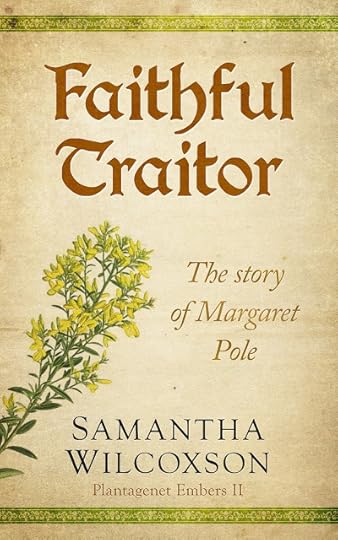
Margaret Pole is no stranger to fortune's wheel. From her childhood as firstborn of the heir apparent of England, she was brought low as the daughter of a traitor. After years of turmoil as the Tudor dynasty made its roots, Margaret finds favor with her cousin, King Henry VIII.
Will the remnant of the York dynasty thrive under this tempestuous king or will Margaret discover that there is a price to pay for having an excess of royal blood?
***
Author’s Inspiration How I became inspired to write about Margaret Pole goes a bit further back than the writing of my last novel. My adventure into Plantagenet Embers began with Elizabeth of York. Hoping to illuminate the life of this much overshadowed Plantagenet princess, I set out to write her story.
Before I had completed Elizabeth’s story in which peace prevails after the Wars of the Roses, I knew that I would have to continue with her cousin Margaret’s journey. Though their fathers were brothers, these women lived much different lives, Elizabeth as Henry Tudor’s queen and Margaret as both victim and beneficiary of fortune’s wheel. Elizabeth had a quiet strength that enabled her to submit to Henry’s rule and partner with him for the good of their kingdom. Margaret, left alone with young children, was forced to carefully make a name for herself without appearing to be a threat to the Tudor king’s reign.
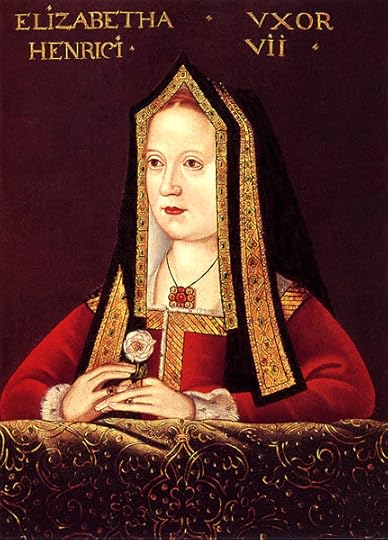
Elizabeth of York
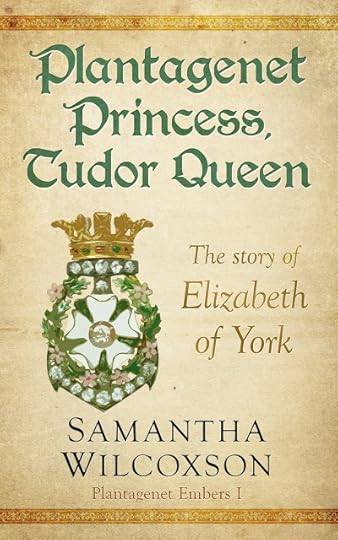
Most people remember Margaret Pole’s name either for her grisly execution or that of her father. I wanted people to know that there was much more to this woman who raised sons with Plantagenet blood during the reign of the tempestuous Tudor king, Henry VIII. She was also more than a mother, claiming the title of Countess of Salisbury that had been last held by her grandfather, ‘Kingmaker’ Richard Neville. She steadfastly stood by her friends and her faith, even as the cost of that loyalty rose shockingly high.
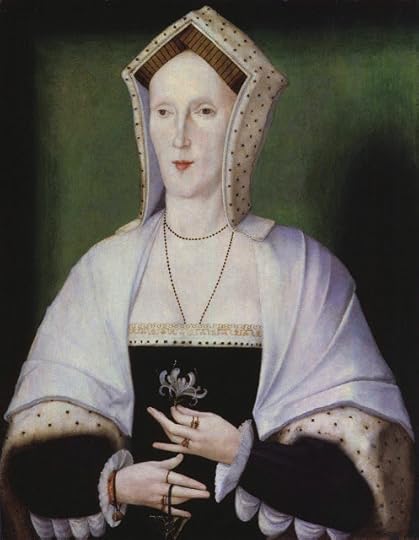
Margaret Pole
Though her life did eventually end in tragedy, Margaret lived life to the fullest, serving as governess to Princess Mary and defending her faith in the Catholic Church when the king insisted that he was the Head of the Church of England rather than the Pope. Margaret was forced to constantly balance her faithfulness to her God and her king, but Henry VIII did not like to share. His temper increased with his age and health problems, leaving Margaret and her family vulnerable to his wrathful whim.
Margaret’s life is an inspiring blend of triumphs, heartache, and the strength of character that brought her through both. She deserves to be remembered as more than the daughter of a traitor or an old woman who was grievously murdered. As Countess of Salisbury, Margaret took on ambitious building projects and had her intricate coat of arms etched into the windows of her home. Advantageous marriages were arranged for each of her children, except for the one who went on to almost become Pope. (Cardinal Reginald Pole will also play an important part in my next book.) She counted Queen Katherine of Aragon as a close friend and served Princess Mary with the same love and dedication that she showed her own children.
I hope that each person who reads Faithful Traitor is touched by the plans made, battles fought, and moments enjoyed by this strong Plantagenet daughter. Even as her dynasty was turning to ashes, she made her own way in a Tudor world.
Margaret Pole lived from 1473 to 1541, an amazing and volatile era in England. The medieval world was passing away and the renaissance taking its place. The Plantagenet dynasty that Margaret was a member of had ruled for more than three centuries, but the short lived Tudor dynasty would work to overshadow it with scandal and drama that is crazier than fiction. Through all this, one woman, Margaret Pole, found and lost love, fortune, and life. It was a privilege to write her story.
Links for Purchase
(UK customers grab your Kindle copy of the Plantagenet Princes Tudor Queen for only 0.99p ~ Bargain!)
Plantagenet Princess Tudor Queen ~ Amazon Faithful Traitor ~ Amazon
About the author
Samantha Wilcoxson is a writer, hopeless bibliophile, and history enthusiast. Living with her husband on a small lake in Michigan with three kids, two cats, and two dogs, she has plenty of writing inspiration.
The Plantagenet Embers series debuted with Plantagenet Princess, Tudor Queen: The Story of Elizabeth of York. It has been selected as an Editors' Choice by the Historical Novel Society and long-listed for the 2016 HNS Indie Award.
Faithful Traitor: The Story of Margaret Pole is the second novel in the trilogy, continuing the story of the Plantagenet remnant in Tudor times. The final installment in Plantagenet Embers, Queen of Martyrs, will feature Queen Mary I and is scheduled for release in 2017.
My blog – http://SamanthaWilcoxson.blogspot.com
Published on October 12, 2016 00:00
October 11, 2016
Melrose Abbey and the Scottish Borders #Scotland
I have a bucket list of historical buildings that I want to visit ~ No jumping out of aeroplanes for me ~ I would much rather explore the remains of ancient castles, battlefields, and abbeys. During my trip to Scotland, I managed to cross off a fair few number of buildings on my list, but there was one in particular that I have wanted to go to for as long as I can remember.
Melrose Abbey(St Mary's Abbey, Melrose)

Why Melrose Abbey? To be fair, I have no idea. I do have a bit of a thing for ruined Abbeys, always have. Maybe, in this case, it has something to do with Robert the Bruce ~ his heart is buried at Melrose. Or perhaps, it is because when asked to name an Abbey in Scotland, Melrose is the first one I think of. Whatever the reason, it was on my must see list.
We spent two nights in the Scottish Borders and boy did we pack a lot in. But I was determined that one of those days was going to be reserved for Melrose.
We woke up bright and early on the day we had planned to visit Melrose. The weather was fine, a little bit on the chilly side, but at least it wasn’t raining. We packed the kids in the car, put Melrose in the Sat-Nav and off we went. But the thing is with Scotland, you can't drive 100m up the road without a sign pointing to yet another historical site, and I am afraid, we did get rather distracted. But it was so worth it for views such as this...
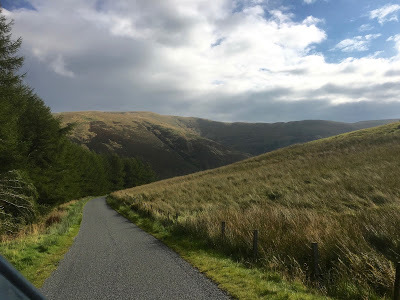

Our first stop of the day turned out to be an unplanned visit to Hermitage Castle. Hermitage Castle has a rather sinister feel to it ~ it certainly has a rather gruesome history...there was that whole witchcraft incident in the 14th Century, which saw the Lord of Hermitage, William De Soulis, boiled in lead by the locals ( or so the legend goes).
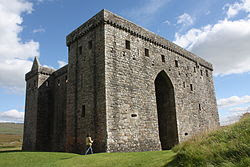
Hermitage Castle
(Photo courtesy of Wikipedia ~ My photos were a little blurry!)
Once we had explored Hermitage Castle we were back on the road heading for Melrose ~ but then we say a sign to Jedburgh Abbey ~ so of course, we had to visit that as well.

Jedburgh Abbey
And then while we were there we visited Mary Queen of Scots House ~ it would have been rude not to. When I say Mary’s House, it wasn’t actually hers. She just so happened to visit a sick friend there once.
So much for taking the day to explore Melrose!
We finally arrived in Melrose in the middle of the afternoon. Melrose is a small town but the amount of traffic was staggering, and there didn’t seem to be an awful amount of parking, but as luck would have it, we finally managed to find a parking spot. For a moment I didn’t think we were going to.

Melrose Abbey was stunning. As soon as I entered the property I had a stupid grin on my face ~ I had finally made it here! My husband, bless him, knew how much I was looking forward to visiting Melrose, told me he would take care of the children while I took the audio tour. So while he and the kids went on a hunt for the bagpipe-playing Pig and other such notes of interest as pointed out by the children’s quiz, I took my time and explored the Abbey. The audio tour brought the Abbey back to life for me, and I learnt a lot about the Cistercian monks and lay brothers that once lived there. I am sure this new knowledge will make its way into a book one day!


We spent just over 3 hours at Melrose and I enjoyed every single minute of it. I could have spent longer there, but the road was calling us as our next stop over was in Ayr and that was a good three hours away.
Published on October 11, 2016 00:00
October 10, 2016
#bookreview ~ The Severaine by K.J. Simmill #fantasy @SimmillKj
The Severaine(The Forgotten Legacies Series Book 2)ByK.J. Simmill
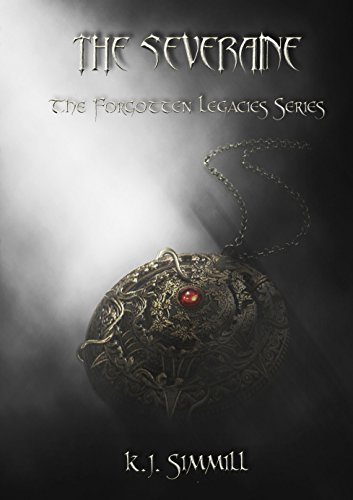
Sequel to the Award winning book, Darrienia.
Civilisations rise and fall leaving only dust and legend in their wake. Kingdoms were lost, and races forgotten. Across the countless span of time one threat rises, heralding the end of man’s rule, and laying to waste those who defiled its mistress. It is known as the Severaine, a power that in vengeance could bring even the Gods themselves to their knees. Each era overcame this peril so a new world could rise from the ashes of old. Lost within such wisdom could be the answers our heroes seek, a means to stop the threat before a new cycle is born.
But legends can lie and history can be mistaken.
There is another tale, a fable on the lips of few, it speaks of the means to force this power into submission, and there are those who would seek to bend this devastating might to their will.
Creatures rise, guardians wake, and sometimes even the meddling hands of man can turn divine plans awry. The prophesies of old were reforged by death and whisper now a chilling truth. If this path continues unobstructed there is only one conclusion. The end of man and god alike.
But there are some secrets that should never be uncovered and paths which mortals must fear to tread.
When revenge knows no boundaries there are some bonds even death cannot destroy.
***
Links to PurchaseAmazon USAmazon UK
***
What did I think of the book?
I have read my fair share of fantasy books, but The Severaine is in a class of its own. With elegant prose and descriptive texts, Simmill has brought this dystopian world alive for her readers. The attention to detail is exquisite. It was so easy to visualize this world and as for the storyline, the word "epic," does not do this book justice. I haven't read such a fantastic fantasy since J. R. R. Tolkien ~ The Lord Of The Rings.
With a cast of believable and likeable characters ~ who struggle with their own personal demons, and a world that is foreign yet strangely familiar, this is a compelling tale of good vs. evil. Each page turn brought new horrors, new struggles but above all else, it showed the strength and spirit of those who would fight for freedom and justice. I really took to the character of Daniel. He is a tortured soul who battles with grief and guilt, as well as a raging desire for revenge. I actually found myself crying while I read about him~ I could feel his pain.
I love how Simmill has cleverly weaved the tales of the ancient Greek Gods, into this unforgettable story. A must read for any fans of mythological fiction.
This is the kind of book where you can snuggle down under a warm blanket, and allow yourself to get lost in the world Simmill has created. I did not want to put this book down, as each turn of the page brought new adventures, new adversaries, as well as a chance to learn more about these unforgettable protagonists.
The Severaine may be part of The Forgotten Series, but I guarantee, you will not forget this book in a hurry! I Highly Recommend.
***
About the author

K.J. Simmill is a British author with books released in both the fantasy and non-fiction genres. It is her intention to ensure each book she writes will donate a percentage of her royalties to a good cause.
She is a qualified Usui Reiki master, with certifications in various fields of holistic therapy. inclusive of aromatherapy, crystal healing, colour therapy, ethereal Reiki, Indian head massage, shaman power Reiki, sound therapy, and massage therapy. She has also spent many years researching various practices of magic and herbal medicine. She is also currently working towards a herbal practitioner qualification.
When she is not writing, she is an avid reader and a passionate gamer.
It is K.J's aim for each one of her titles to donate a percentage of the author royalties to a different charity. Herbal Lore is donating 15% to The St John and Red Cross Defence Medical Welfare Service (DMWS) and Darrienia is donating 10% to the University Hospital of North Midlands (UHNM) charity directed towards the Neonatal intensive care unit.
Published on October 10, 2016 00:00
October 6, 2016
"Bloody. Brutal. Bannockburn." An adventure not to be missed @BattleofBannock
Bannockburn
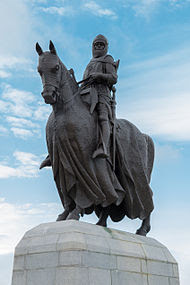
I asked my children, when we got home, what was their favourite historic site that they visited in Scotland. They all said the same thing,"Bannockburn." I shall tell you why in a minute.
It has been over 16 years since I last visited Bannockburn and I was looking forward to showing my children the statue of Robert The Bruce on his horse, but as we pulled up in the car park, I realised that 16 years was a long time. They had built a new visitor center and I couldn't wait to get inside!
When we bought our tickets, we were asked if we would like to go on the museum tour and of course, we said yes. She then produced some 3D glasses. "You'll need these." Interesting, I thought.
It was twenty minutes until the next tour, so we decided to head outside and go and see that famous monument.

The Battle of Bannockburn Visitor Centre isn't quiet on the battlefield, but is built in what was the Scottish Camp. There really isn't a better place for a monument for those Scottish hero's who fell. Bannockburn was the ultimate Scottish victory against King Edward II. They did, after all stand…
"...against him,Proud Edward's Army,And sent him homeward,Tae think again."
The monument was beautiful and peaceful ~ peaceful, yes, I think that is the word I am looking for. It was a place to reflect and to remember all those who died that day.

We wondered back inside in time for the tour.
When I woke up in the morning, I wasn't expecting to find myself in the middle of The Battle of Bannockburn, with arrows whizzing over my head, horses charging right at me and people dying to my left and my right. I mean nobody expects that? Right? But this is what you get at Bannockburn. Bannockburn has invested in state of the art, 3D technology so you experience, safely, what the battle was like. Wow! It was amazing. A little gruesome, but not so scary that it is unsuitable for children. It was truly incredible. I have been to some of the best visitor centers in Britain, but this one...this is something else. Oh, my days! It was ~ I'm sorry, I am running out of adjectives to describe it! And that wasn't all....
The tour continued...we got to - in their own words
"Walk the battleground, guide your own army of medieval soldiers through the 3D simulation and visit the all important Bannockburn; a stretch of water that proved the turning point in the battle."
If you have ever played Rome Total War, it was the same principle, but on a bigger scale. How awesome is that?
The wonderful guide split us into teams, and we stood around this huge map of the terrain while he showed us how the battle of Bannockburn played out and then it was our turn. We were going to make the decisions. We were going to fight. We were going to watch the battle unfold on the map in front of us. My youngest, who is 6, was crowned King Robert of Scotland, and it was a role he took very seriously, although he seemed to be slightly more concerned with killing his brother who was an English knight than victory over the English army - talk about family loyalty! It went out the window.
There were a lot of nervous faces when the guide asked for instructions.
"Where do you want your knights? Speak up, I can't hear you."
"You want to put them against the schiltron? Did you wake up suicidal?"and so it went on!
It wasn't the most predictable of battles, but it was certainly entertaining. The Black Douglas turned tail and ran back to Stirling ~ I'm not too sure what he would have made of that if he were still alive! But King Robert - my son - was much more decisive and he led his troops to victory over the English Queen ~ yes I did say Queen ~ it is pretend ~ Robert the Bruce wasn't really 6 when he fought the English at Bannockburn! The Scots were victorious although victory wasn’t actually decided at Bannockburn but Stirling. History was rewritten! The result was the same, and that is the main thing! I think…
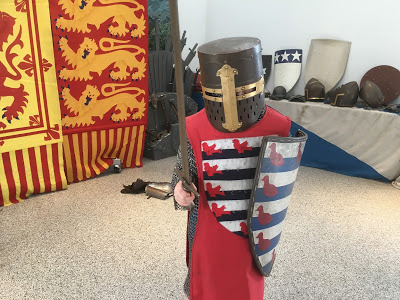 My youngest, ready for battle ~ although he couldn't see where he was going!!
My youngest, ready for battle ~ although he couldn't see where he was going!! Talk about bring history to life. You couldn't get any better than this.
When asked about Scotland this is the first thing my children want to talk about, followed secondly by something else that happened at Gretna Green ~ but that my friends, is for another day!
Published on October 06, 2016 00:00
The Coffee Pot Book Club
The Coffee Pot Book Club (formally Myths, Legends, Books, and Coffee Pots) was founded in 2015. Our goal was to create a platform that would help Historical Fiction, Historical Romance and Historical
The Coffee Pot Book Club (formally Myths, Legends, Books, and Coffee Pots) was founded in 2015. Our goal was to create a platform that would help Historical Fiction, Historical Romance and Historical Fantasy authors promote their books and find that sometimes elusive audience. The Coffee Pot Book Club soon became the place for readers to meet new authors (both traditionally published and independently) and discover their fabulous books.
...more
...more
- Mary Anne Yarde's profile
- 159 followers



